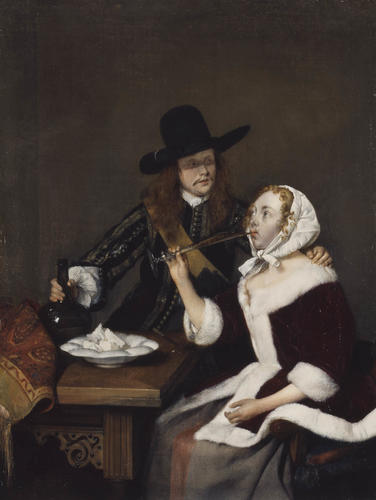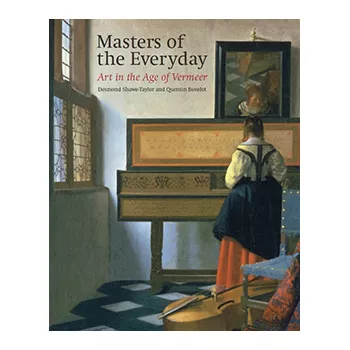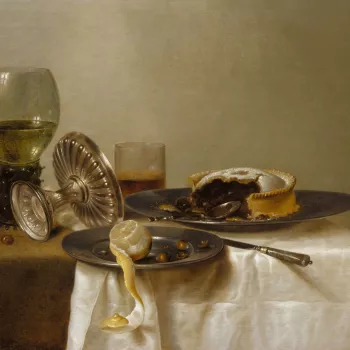A Gentleman pressing a Lady to drink c.1658-9
Oil on canvas | 41.5 x 32.0 cm (support, canvas/panel/stretcher external) | RCIN 404805
-
A gentleman pressing a lady to drink is a characteristic example of a genre scene by ter Borch of the 1660s, although in this instance the compositional possibilities are more circumscribed by the simplicity of the setting. In the interaction of the two figures and the attention to detail ter Borch still manages, as so often in his work, to engage the viewer’s attention to an unusual degree.
The painting has an implied narrative of seduction, the outcome of which is left to the imagination. A shadow falls across the man’s face; his left hand is placed on the young woman’s shoulder while with the other he holds on to the neck of the bottle of wine. It is a striking, almost sinister pose, countered by that of the young woman, whose compliance is registered by the raising of the tulip glass to her lips while gazing into the man’s eyes. The model for the female figure is an idealised type often said to be based on the artist’s gifted step-sister, Gesina ter Borch, who appears in many of these genre paintings. The care lavished on the fur-trimmed garment, the cap and the curls of hair epitomises ter Borch’s meticulous degree of finish, just as the psychological overtones inherent in the scene explain the artist’s appeal to modern viewers. The plate of cheese on the table may have an iconographical significance, but is as yet unexplained.
The subject of a figure drinking, or being encouraged to drink, is not unusual in ter Borch’s oeuvre. It can also be found in Vermeer - 'The Glass of Wine', c.1658-60 (Gemäldegalerie, Berlin), and 'The Girl with the Wineglass', c.1659-60 (Herzog Anton Ulrich Museum, Brunswick), both compositions conceived on a different level of technical sophistication. It is known that ter Borch had met Vermeer in Delft in 1653.
This painting was in France during the mid-eighteenth century; the French had a particular penchant for this type of Dutch painting.
Catalogue entry adapted from Enchanting the Eye: Dutch paintings of the Golden Age, London, 2004Provenance
Peilhon sale, Paris 1763; Abbè Le Blanc sale, Paris 1781; bought by Lord Yarmouth for the Prince Regent; received at Carlton House on 9 May 1812; recorded in the Upper Anti Room at Carlton House in 1816 (no 148) and in the Anti Room to the Dining Room in 1819 (no 79); in the Picture Gallery at Buckingham Palace in 1841 (no 120)
-
Medium and techniques
Oil on canvas
Measurements
41.5 x 32.0 cm (support, canvas/panel/stretcher external)
56.3 x 47.1 x 5.5 cm (frame, external)
Category
Object type(s)
Other number(s)











